Tharp's Thoughts Weekly Newsletter (View On-Line)
-
Article Where Does the Fed's Stimulus Money Go? by D. R. Barton, Jr.
-
-
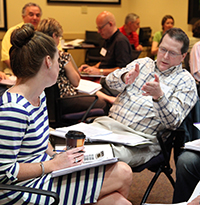 $700 Discounts Expire Today on Peak Workshops in October $700 Discounts Expire Today on Peak Workshops in October
Due to a few cancellations, we now have seats available in all three workshops!
If you can swing the last minute travel arrangements we'd love to fit you in!
Call us to register 919-466-0043
 Where Does the Fed’s Stimulus Money Go? Where Does the Fed’s Stimulus Money Go?
The Obscure, Convoluted and Scary Story
by D. R. Barton, Jr.
View On-line
The single worst cholera outbreak in England’s history happened in 1854 in the Soho district of London. It left hundreds dead, although the broader cholera epidemic around London claimed tens of thousands of lives. At the time, the world did not know that microorganisms caused many diseases (Louise Pasteur would not discover what has become known as “germ theory” until several years later). In fact, the prevalent common knowledge was that diseases like cholera where caused by “bad air.”
So when physician John Snow eventually traced the outbreak to a single public water pump (the infamous Broad Street pump), he had to make an overwhelming data argument to convince public officials to shut down the water source by removing the pump’s handle. The thoroughness of his study and his hypothesis that people could get sick from drinking contaminated water made Snow a seminal figure in the fields of public health and epidemiology. He’s also a hero figure in entry level texts about water treatment.
The parallels to today’s seemingly infinite “pump priming” by the Fed (and other central banks) are ironic, to say the least. Snow didn’t understand what was going on in the water to make people sick — he just knew he had to get people to stop drinking it. In the same way, most investors and traders don’t really understand the inner workings of money creation in today’s world, but they can sense that our central bank’s “money pump” could lead to an economic epidemic. In a real last turn of irony — after the cholera epidemic of 1864 had waned, government officials put the handle back on the Broad Street pump, allowing the flow of dangerous water to continue… Does that ring a bell to anyone who listened in last week to the Fed’s “keep the spigot flowing” decision? Let’s dig in to see what the addition of $2.2 trillion dollars has bought us in terms of liquidity and economic growth so far.
The Obscure Part: Has All the Stimulus Been Helping?
Lots of stimulus has been tossed into the system. In fact, let's take a quick look at the M1 chart, one many of you will be familiar with —
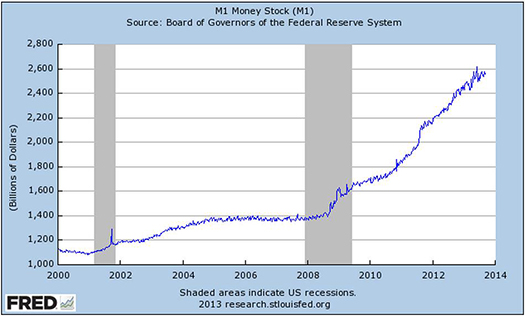
But has any of this trickled down to Main Street? Spoiler alert — the velocity of money (the financial lubricant that our credit-driven system so badly needs to thrive) has actually dropped and the bulk of the stimulus money has found its way into risk assets like the stock market, not into growth areas of business and real estate loans. Alas, Main Street is left holding the bag — taxes and deflated dollars are paying for the largess that allows large institutions to play with the Fed’s exponentially expanding balance sheet as if it were Monopoly Game money.
Let’s look at perhaps the most disturbing picture first. Trillions of dollars of stimulus is put into the system while household incomes are actually dropping - by a lot. Below is a graph of the Census Bureau’s latest data.
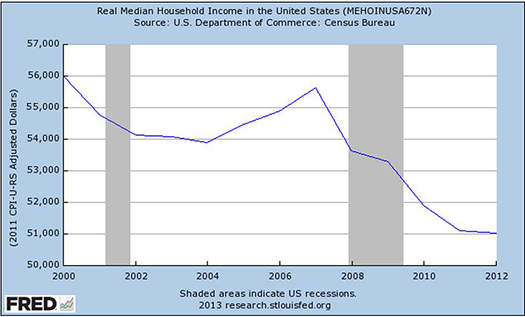
Since 2007 (not the highest point on the chart, mind you), Real Median Household Income has dropped more than 8 percent. Not exactly a victory for Joe or Jane Sixpack, but at least all this stimulus has helped out the employment picture, right? The Fed’s infamous dual mandate includes fighting inflation and maximizing employment. So what kind of jobs growth does TRILLIONS of new dollars buy you? Let’s head back to the Fed’s own database:
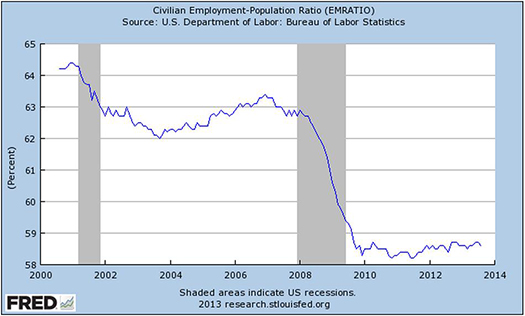
Ouch — this one is still startling. Despite all the bluster from Washington, the U.S. employment picture is pretty darn flat (and at an unacceptably low level) since late 2009. It’s also one of the reasons cited last Wednesday by the Fed for keeping the handle on the stimulus pump.
But at least some things have been getting better — namely risk assets:
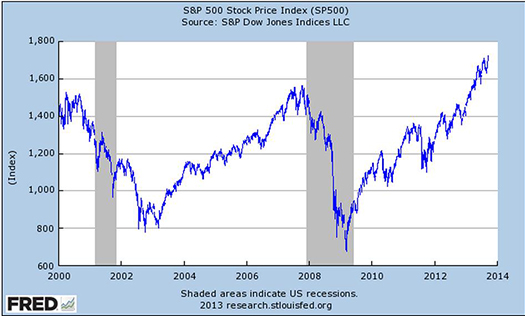
Who knew that the Fed kept stock price charts on their site? Here you have one of the main locations where all the Fed stimulus has landed. How it got there takes a bit of explaining.
The Convoluted Part: How Fed Stimulus Gets Into the Markets
Here's a very insightful chart that I couldn’t get from the St. Louis Fed site. It looks at that big rise in stock market cap divided by the Fed’s burgeoning balance sheet (source: Haver Research and Gluskin Sheff):
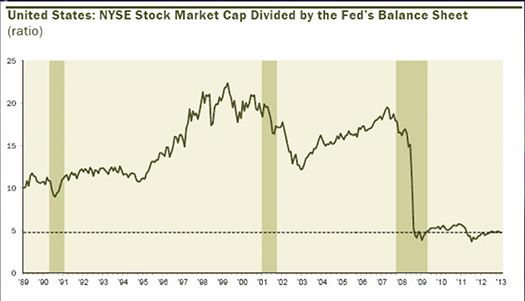
As you can see, since the beginning of the stimulus, the market’s capitalization has essentially kept pace with the Fed’s money pump. This gives us some hints about stimulus money and the market but we are missing an important piece of the path. Let’s dig deeper.
In a very illuminating Working Paper entitled Collateral and Monetary Policy, Manmohan Singh of the International Monetary Fund gives a mind-numbing look into the new money creation paradigm that the Fed has created (more details on that will have to wait for a later article). For our purposes today, let’s cut straight to how QE money from the Fed winds up in the stock market instead of going out as new business or real estate loans. Let’s start with an astonishing chart from the folks at Zero Hedge. They have taken data straight out the Fed’s H-8 report and made some simple bar graphs showing U.S. bank balance sheets before the stimulus hit the fan up to now:
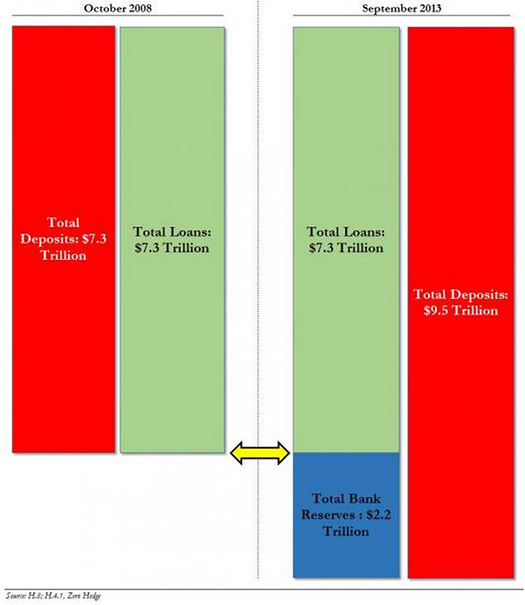
Here you can see that the banks’ balance sheets have grown by $2.2 trillion as the Fed buys Treasuries or Mortgaged Backed Securities from them. As Singh describes in great detail — the immediate effect is to increase bank deposits (as shown above). It’s up to the bank to decide how to handle these new deposits; it can loan them out or use the “deposit to loan gap” for other purposes.
Again, Zero Hedge (with an assist from JP Morgan) gives us some insight into what one commercial bank did with its newly acquired deposits last year:
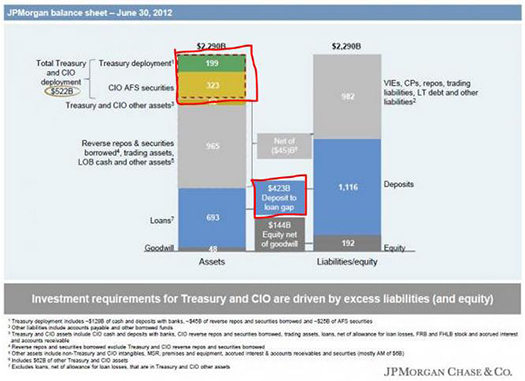
(to see a larger version of this chart, click here)
The red lined blue box in the center column above represents JP Morgan's $423 billion deposit to loan gap. On the left, the yellow portion of the red lined box is $323 billion labeled as “CIO AFS securities” (Chief Investment Office Available for Sale securities). What happened next is well known to anyone following the financial news; the so-called London Whale in JP Morgan’s CIO group (with full knowledge of the company executives) took on huge positions that cost the company billions of dollars in losses in a truly excruciating proprietary (prop) trade gone bad. The whale story may be intriguing but its details hide a significant point highlighted by the chart above. Most importantly, it lets’ us see the inner workings of how stimulus money goes from the Fed to the securities market without ever leaving the bank’s balance sheet (it is marked as a liability — essentially lent to itself). The underlying deposits can then be leveraged and used by prop trading desks to return outsized gains (in theory and usually in practice, though not in the case of the London Whale) versus what could have been made through loans to real estate investors, businesses, and consumers.
What's scary is that this is not even the scary part.
The Scary Part?
I'll leave you with these departing thoughts and one more chart: the current usage of all of this extra money has DECREASED the velocity of money, the speed of its movement through the economy while it has INCREASED the systemic risk.
First for monetary velocity: more money is doing less (being loaned out, etc.) since the stimulus has started. Singh estimates that collateral turnover has dropped from 3x in 2007 to 2.2x in 2012. And the Fed’s own measure of velocity shows a clear drop:
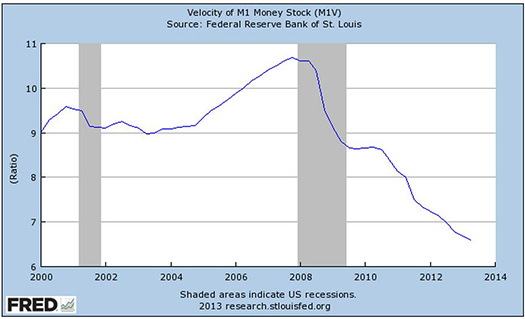
The importance of the velocity of money can be found in the definition from the FRED site, “The velocity of money is the frequency at which one unit of currency is used to purchase domestically-produced goods and services within a given time period. In other words, it is the number of times one dollar is spent to buy goods and services per unit of time. If the velocity of money is increasing, then more transactions are occurring between individuals in an economy.”
Velocity of money tells us how much money in circulation is being used as a lubricant — reducing the friction for economic transactions. As we can see above, we are well past the point of diminishing returns.
Now about that systemic risk — banks’ balance sheets have swelled thanks to the Fed’s ever-present purchases. These additional reserves would seem to provide added safety for banks until you look at their nature. In a vast over-simplification, the Fed has been buying the banks’ highly liquid AA+ rated securities (e.g. Treasuries, etc. — which are very easily traded on the open market) and has been replacing them with bank reserve deposits at the Fed - which are only available for interbank trade.
Peter Stella of Stellar Consulting LLC wrote a detailed and illuminating piece on the implications of the current bank reserve situation just last Friday. Stella points out that the massive shift in bank holdings from liquid US Treasury securities to Fed bank reserve deposits does not pose a credit risk issue; Fed reserves and treasuries are equally safe. Fed reserve deposits, however, are marketable only to a very select audience, namely US banks. The shift in trillions of dollars of bank holdings out of very liquid securities to much less liquid Fed reserve deposits has injected a new systemic risk into the economy. This money supply / bank reserve relationship will be the subject of our next article.
If you’ve found this article useful or thought provoking (or both), I’d love to hear your thoughts and feedback — just send an email to drbarton “at” vantharp.com.
Great Trading,
D. R.
About the Author: A passion for the systematic approach to the markets and lifelong love of teaching and learning have propelled D.R. Barton, Jr. to the top of the investment and trading arena. He is a regularly featured guest on both Report on Business TV, and WTOP News Radio in Washington, D.C., and has been a guest on Bloomberg Radio. His articles have appeared on SmartMoney.com and Financial Advisor magazine. You may contact D.R. at "drbarton" at "vantharp.com".
Disclaimer
Back to Top
Trading Education
We are excited to release our November schedule which includes two brand new workshops, presented by Ken Long.
October 3-14 |
• Peak Performance 101 • Peak Performance 202 •
• Peak Performance 203 •
Limited space still available. Call to register. |
| November 8-10 |
Swing Trading Systems Workshop
with Ken Long
8:00am-4:30pm |
| November 8-10 |
NEW! Turbo Charge these Swing Systems
with Ken Long
6:00pm-9:00pm
Stay late and Ken will show you how to use swing trading systems to catch intra-day moves. |
| November 11-12 |
NEW! Live Trading for Turbo Systems
with Ken Long
2 days of live trading alongside Ken Long |
November 16-17 |
Oneness Awakening Weekend
with Van Tharp and Janie Guill |
December 8-15 |
The Annual Super Trader Summit
Click here to learn about the Super Trader Program |
To see the full schedule, including dates, prices, combo discounts and location, click here.
2014 dates will be coming in the next few months. If you are in South Africa and would like have Van host a workshop there, please contact us at [email protected]. There is a possibility he will be visiting South Africa in early to mid 2014.
|
Back to Top
Trading Tip
Matrix Insight: Miracles
by A Loyal Reader
View On-line
I have been trading professionally for about 6 years now with a proprietary firm. I have had some very successful periods mixed with some periods of what I use to view as huge missed opportunities. However, they have all lead me to be where I am presently, which is in the now. This is a state I have never really achieved all my life apart from maybe a year in very early adulthood. How did I get here?
I had 3 months off earlier this year, where I changed companies. It was not a great time to be out of the market as there was so much opportunity in the product that I trade, but I believe those 3 months had so much more impact on my life and on my trading. I discovered Trading Beyond the Matrix and read it cover to cover in about a week. It was a great read but I got probably 5% of the real benefit from it the first time as I skimmed through the exercises. The book did however introduce me to Oneness, and given I wanted to practice meditation more frequently I thought I would attend a Oneness group here in Hong Kong. The first deeksha night I attended was actually in the presence of a Oneness meditator from the US, so in hindsight I was quite 'lucky' (now I refer to it as a miracle). I kept attending these deeksha nights, and had some great conversations with Karuna who runs the center. He suggested I go to India for a Deepening Process. I had the time available to me and from Hong Kong its not far so I thought why not (again, another miracle, but at the time I did not identify with it as such).
So about a month after my first deeksha night, I was in India (with many miracles involving airlines and visas). I seemed to be a real outlier in that most attendees had been involved with Oneness for years and planned their time there way in advance. When I told them how I ended up there, 'Wow' was the common response. Little did I know that my Divine had paved the way for all this, something for which I will be eternally grateful.
I tried to keep a very open mind about Oneness and just experience the time I had there, but I must admit some doubts and reservations existed as I really knew very little about the Oneness movement. These doubts and reservations seemed to melt away as my deepening process continued. I found a book at the temple, Awakening into Oneness, (another miracle). This book helped my analytical part to satisfy itself that Oneness was not a cult or money making scam (these criticisms were some of the first things I came across when I googled Oneness).
No matter how people describe their experiences in the process, unfortunately they can never really truly convey the experience itself. I had feelings of absolute bliss, god realizations and experiencing pure consciousness. I cannot even come close to helping the reader know what these experiences are actually like, but I will say they are beyond this world and reality as I use to know it. I actually now see that old reality as an illusion. I will describe the changes in my state.
Before the Deepening Process:
- Everything seemed to be a struggle.
- Motivation to do self-work was low, in that I had parts that would create obstacles.
- Lived in thoughts about the past and future, and got bored with the present.
- Discontent with many aspects of life.
Post-Deepening Process:
- Discovery of one of the most powerful 'tools' in life — Gratitude.
- Continual conversations with my Divine/s.
- Discovery of multiple Divines, of which they made me aware that they are not permanent but will be there when I need and I should be open to relationships with 'new' divines in the future.
- Realization that I am my Divine/my Divine is me/my Divine is God/God is my Divine/I am God/God is me (these last few may sound delusional to some but it is a natural, logical progression once on this path).
- I experience Life.
- I experience the now.
- Much more content with my current state (while still working towards goals).
- Noticing parts of myself or emotions as just that, a part or an emotion.
The most amazing part of what transpired with all this, is all this happened in an automatic way. For many many years, I use to work at getting to 'there'. I read the Sedona method, tried to read ACIM about 3 times, and tried various other processes. In short, I had a part that thought the knowledge of such things would help me progress. I don't think I am alone when I say that after you gained the knowledge of a process, and trying a few times without any great results you would look for something else.
Now I am 'here' but it is just the very beginning. I now meditate on a daily basis because I want/choose to meditate on a daily basis. I give gratitude for many little things throughout the day, not as a chore, but because it feels great to do so and we should be grateful for these gifts. Further, I look back at this period and don't view anything in isolation. That is, I could feel changes taking place before I got to India, and attending my first Deeksha night came after reading Trading Beyond the Matrix and maybe something that was previously undesirable lead me to read this book. There is no chance, it happened as it was meant to happen.
Where am I know?
- Currently completing ACIM (A Course in Miracles) after many years of trying
- Daily meditations
- Daily journaled conversations with my Divine
- Journal of trading activities
- Working though the Peak Performance Course
- Continually referring back to Trading Beyond the Matrix
- Attending Ken Long's workshop in November
- Hopefully attending all the Peak Performance Courses next year
As you can see from the above, I am very much onboard with VTI. I read Market Wizards years ago and skimmed over the last chapter thinking thats not so much for me. How far from the truth I was...now, but I was correct back then as it was not for me...then.
Lastly, I have to say to anyone that is looking for a good place to start with Van's work, there really is no better place than Trading Beyond the Matrix. It is in itself a standalone course that if followed as intended by its creator, can bring you a huge amount of benefit for a fraction of the price (but not the work required by the individual) of all the other materials. That being said, I think I still have only uncovered not even half the benefit and rest assured I will be working through the equivalent of the Super traders program in due course. At the very least, its a good read for any trader.
Van, I would like to commend and congratulate you on what you have created and are helping people achieve, it is truly wonderful.
Editor's Note: Recently, we wrote to you to tell you about a new contest. We want to hear about the one most profound insight that you got from reading Van's new book, Trading Beyond the Matrix, and how it has impacted your life. If you haven't purchased Trading Beyond the Matrix yet, you can do so here. When you are ready to tell us about your insight, send an email to [email protected]. We are looking forward to hearing from you. If we pick your submission we will share it this newsletter.
Back to Top
For Absolute Beginners
If you are new to trading and want to learn the basics of trading the Tharp Think way, our ABCs of Trading E-learning course is right for you.
- Do you want to figure out what markets and what types of trading might suit you?
- Are you at a loss for how to begin?
This course will answer those questions (and many more) in easy-to-follow lessons written in terms that any trading novice can understand.
Only $49.00
Click here to learn more.
Ask Van...
Everything we do here at the Van Tharp Institute is focused on helping you improve as a trader and investor. Consequently, we love to get your feedback, both positive and negative!
Click here to take our quick, 6-question survey.
Also, send comments or ask Van a question by clicking here.
Back to Top
Contact Us
Email us at [email protected]
The Van Tharp Institute does not support spamming in any way, shape or form. This is a subscription based newsletter.
To change your e-mail Address, e-mail us at [email protected].
To stop your subscription, click on the "unsubscribe" link at the bottom left-hand corner of this email.
How are we doing? Give us your feedback! Click here to take our quick survey.
800-385-4486 * 919-466-0043 * Fax 919-466-0408
SQN® and the System Quality Number® are registered trademarks of the Van Tharp Institute
Be sure to check us out on Facebook and Twitter!
 
Back to Top |